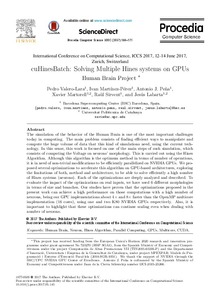cuHinesBatch: solving multiple hines systems on GPUs Human Brain Project

Visualitza/Obre
10.1016/j.procs.2017.05.145
Inclou dades d'ús des de 2022
Cita com:
hdl:2117/106615
Tipus de documentArticle
Data publicació2017
EditorElsevier
Condicions d'accésAccés obert
Llevat que s'hi indiqui el contrari, els
continguts d'aquesta obra estan subjectes a la llicència de Creative Commons
:
Reconeixement-NoComercial-SenseObraDerivada 3.0 Espanya
ProjecteHBP SGA1 - Human Brain Project Specific Grant Agreement 1 (EC-H2020-720270)
COMPUTACION DE ALTAS PRESTACIONES VII (MINECO-TIN2015-65316-P)
IJCI-2015-23266 (MINECO-IJCI-2015-23266)
COMPUTACION DE ALTAS PRESTACIONES VII (MINECO-TIN2015-65316-P)
IJCI-2015-23266 (MINECO-IJCI-2015-23266)
Abstract
The simulation of the behavior of the Human Brain is one of the most important challenges today in computing. The main problem consists of finding efficient ways to manipulate and compute the huge volume of data that this kind of simulations need, using the current technology. In this sense, this work is focused on one of the main steps of such simulation, which consists of computing the Voltage on neurons’ morphology. This is carried out using the Hines Algorithm. Although this algorithm is the optimum method in terms of number of operations, it is in need of non-trivial modifications to be efficiently parallelized on NVIDIA GPUs. We proposed several optimizations to accelerate this algorithm on GPU-based architectures, exploring the limitations of both, method and architecture, to be able to solve efficiently a high number of Hines systems (neurons). Each of the optimizations are deeply analyzed and described. To evaluate the impact of the optimizations on real inputs, we have used 6 different morphologies in terms of size and branches. Our studies have proven that the optimizations proposed in the present work can achieve a high performance on those computations with a high number of neurons, being our GPU implementations about 4× and 8× faster than the OpenMP multicore implementation (16 cores), using one and two K80 NVIDIA GPUs respectively. Also, it is important to highlight that these optimizations can continue scaling even when dealing with number of neurons.
CitacióValero-Lara, P., Martinez-Perez, I., Peña, A., Martorell, X., Sirvent, R., Labarta, J. cuHinesBatch: solving multiple hines systems on GPUs Human Brain Project. "Procedia computer science", 2017, vol. 108, p. 566-575.
ISSN1877-0509
Versió de l'editorhttp://www.sciencedirect.com/science/article/pii/S1877050917307172#fn1
| Fitxers | Descripció | Mida | Format | Visualitza |
|---|---|---|---|---|
| 1-s2.0-S1877050917307172-main.pdf | 590,1Kb | Visualitza/Obre |


